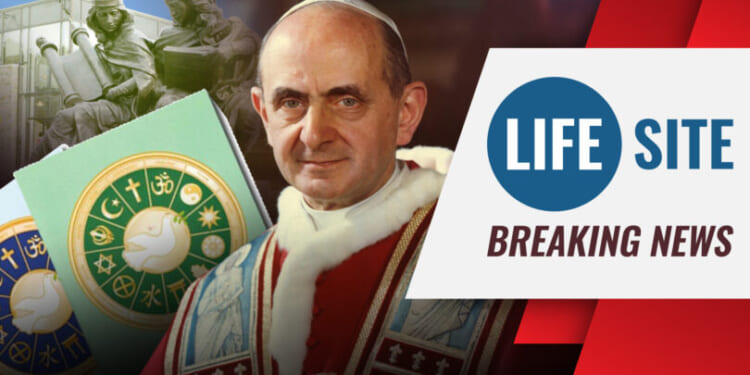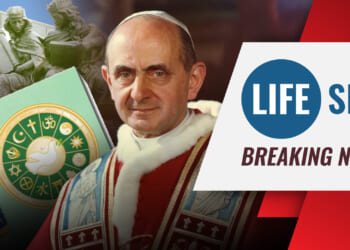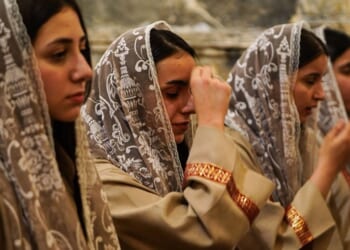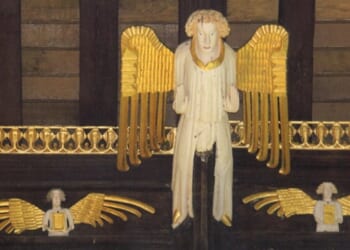(LifeSiteNews) — The Vatican celebrated on Tuesday the 60th anniversary of Nostra Aetate, the Declaration on the Relation of the Church to Non-Christian Religions, by paying homage through dance to Hinduism and Islam alongside Christianity.
A recording of the commemoration, held in the Paul VI Hall, shows women dressed in traditional-style garb dancing to Eastern and Middle Eastern music. During the dances, a woman alternately held up signs with an “Om” Hindu symbol, a picture of a crucifix, and an Islamic crescent and moon, as if to suggest that all religions are on equal footing.
The entire event, including the concluding speech by Pope Leo XIV, was permeated by the value of dialogue and “friendship” between religions rather than the traditional Christian mandate to “go and make disciples of all nations,” that is, convert them to the true faith.
Leo said during his closing remarks that Nostra Aetate “opened our eyes to a simple yet profound principle: dialogue is not a tactic or a tool, but it’s a way of life – a journey of the heart that transforms everyone involved.” This statement suggests, contrary to Christ’s Great Commission, that dialogue is not meant to be a means toward conversion, but rather an end in itself.
Nostra Aetate itself is marked by this false ecumenical attitude, since it “does not actually exhort non-Christians to convert to Christ and His Church in order ‘to be saved and to come to the knowledge of the truth,’” as Matt Gaspers has noted for Catholic Family News.
The document instead claims that the Church “esteems” non-Christian religions and “exhorts her sons, that through dialogue and collaboration with the followers of other religions … they recognize, preserve and promote the good things, spiritual and moral, as well as the socio-cultural values found among these men.”
Nostra Aetate goes so far as to suggest that men can reach God through pagan religions such as Hinduism and Buddhism, in stark contradiction to the longstanding teaching of the Church and the Syllabus of Errors’ condemnation of the idea that “Man may, in the observance of any religion whatever, find the way of eternal salvation, and arrive at eternal salvation.”
The Vatican II document falsely claims that “in Hinduism, men contemplate the divine mystery,” and that Buddhism “teaches a way by which men … may be able either to acquire the state of perfect liberation, or attain, by their own efforts or through higher help, supreme illumination.”
So-called “liberation” or “illumination” is impossible through a non-Christian, pagan religion such as Buddhism or Hinduism. By worshipping multiple false gods, these religions in reality pays homage to demons, as both the Old Testament and New Testament Scriptures affirm: “For all the gods of the Gentiles are devils: but the Lord made the heavens.” (Ps. 95:5) “But the things which the heathens sacrifice, they sacrifice to devils, and not to God. And I would not that you should be made partakers with devils.” (1 Cor. 10:19-20)
For these and other reasons, the Priestly Society of St. Pius X (SSPX) as well as other priests and scholars have called for the retraction of Vatican II documents, including Nostra Aetate.
Archbishop Guido Pozzo, the Secretary of the Pontifical Commission Ecclesia Dei, pointed out about a decade ago that “Nostra Aetate does not have any dogmatic authority, and thus one cannot demand from anyone to recognize this declaration as being dogmatic.”
During Tuesday’s Vatican celebration, Cardinal Kurt Koch, Prefect of the Dicastery for Promoting Christian Unity, shared that Nostra Aetate, remarkably, was in part prompted by the request of a Jewish historian.
“On the occasion of the meeting between Jules Isaac and Pope John XXIII on June 13, 1960, the Jewish historian presented the pope with a memorandum urgently calling for a new (way) of the Church relationship with today’s (man),” said Koch. “Pope John took up this request and commissioned the drafting of a declaration which … resulted in Nostra Aetate.”

















